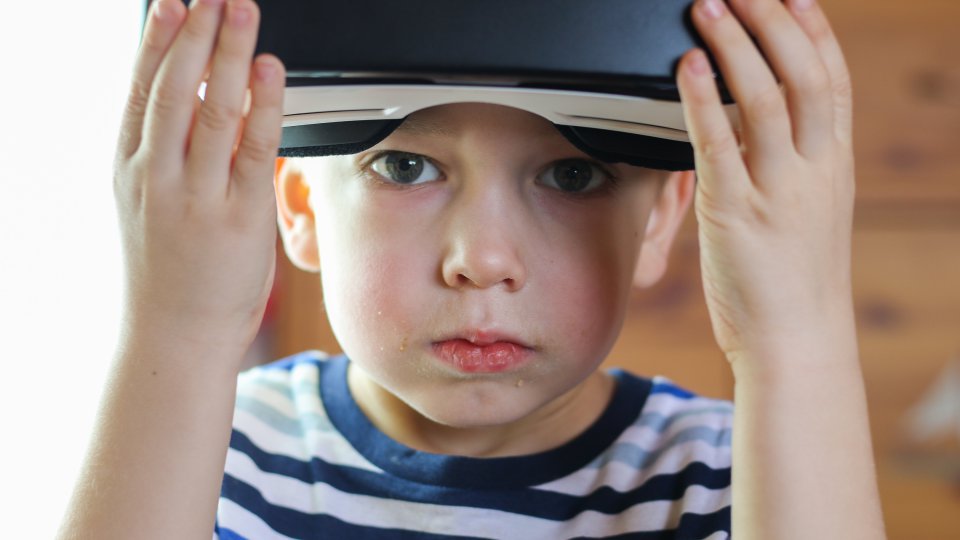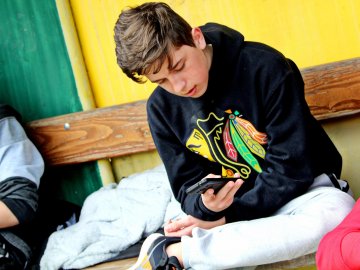Television companies and content producers have all but given up on what was going to be the next big thing: 3D. The limits of the immersive effect and the fact you had to wear stupid glasses, couple with high cost, killed the idea before it became mainstream.
To address 3D’s shortfalls they are now coming back with the next big thing – Virtual Reality. Billed as being far more immersive than 3D, VR brings the action right up close to your face, puts the viewer in control of the camera, and where games are concerned – the action too.
So what are the issues with VR, and will it have a beneficial or detrimental effect on you and your children?
What will we use VR for?
VR is a very young technology, which has yet to find its place in the world. If you listen to technology companies they could chew your ear off about how in the future we will use VR for everything, but in reality as the technology matures it will find its place.
The most obvious application is gaming and immersive experiences, this is currently where the technology and content is being developed.
But big investors like Facebook who bought a VR startup called Oculus in 2014 for $2billion clearly see a future for VR beyond this. Once we have cheap and easy to deploy motion tracking systems and the processing grunt to generate truly immersive virtual worlds, expect us all to be talking to computer generated versions of ourselves in virtual worlds.
Benefits of VR
Imagine being able to learn to fly a plane, or visit one of the seven wonders of the world with some of your friends who are currently in another country?
The potential impact of VR is huge, it has a number of hurdles to overcome in its future to get us to a place where we can all hang out in a virtual space, and do things that would be impossible in the real world.
The benefits could be enormous, especially in the social space and represents another level in connecting us together over great distances. With virtual versions of ourselves meeting in a virtual space, for fun, for a meeting, to try out a new product designed on the computer but that doesn’t exist in the real world yet, or to shop, the potential to shrink the world and experience new ones if off the scale.
Indeed the army is already experimenting with VR to offer remote support to troops out in the field, where for example if your vehicle breaks down, support engineers could help you to find the problem, send you part blueprints to print on a 3D printer, and then help you install it, all in a blend of real and virtual worlds.
Issues to consider
Immersion
VR is a much more immersive technology than any previous attempts, due to the fact your entire visual sense is connected to the virtual image, usually along with the ability to control the view direction with your head using gyroscopes built into the device. More expensive systems also integrate other motion trackers to track your position in a space, enabling you to also control movement and elevation.
The resolution and quality of the images you see can have an effect on how immersive an experience can be, but this will be more down to your imagination as to how real the experience feels.
Sometimes the depth of the immersion can be disorientating, especially if you are immersed in content that may shock or excite you. Immersing yourself in a virtual experience for long period can make you feel tired, especially considering current experiences are designed to excite you.
Real World Space
Where movement tracking is used, it is essential that your real world space is large enough to contain your virtual world, and that it is free of obstacles. Currently most experiences are designed to be enjoyed from the comfort of your armchair, which provides real world safety whilst you are in your virtual one.
Nausea
Differences between what you are seeing and hearing in the virtual space, and the feedback that you are getting from your real world can confuse your senses and can make you feel nauseous. This is where quality motion tracking and image synchronisation can make a huge difference to your experience.
Some people are more sensitive to conflicting feedback information and may be more prone to a feeling of sickness. Limiting your experience time to between 5 – 15 mins at a time will help prevent disorientation and sickness.
Blue Light
Screens of all types send LED generated light to your eyes, the light strength, refresh rate, and frequency can affect our natural rhythms which when over-exposed can disrupt sleep, appetite, and our social skills.
A VR headset is essentially a giant screen sending light to our eyes from all angles, so the effect will be magnified. Over exposure could also affect your sight if the experiences cause your eyes to be over worked.
Screen Technology
In the future it would be great if we have developed new types of screens that generate light more akin to what we experience in the real world, or perhaps the future will be like the Microsoft vision of the future of VR, where virtual objects will be mapped over the real world. This will help virtual worlds feel more real, and help alleviate some of the issues surrounding extended screen use.
Image Projection
As VR becomes social, the kids are going to be all over it. As we are seeing currently, the advent of social media and pervasion of image on the Internet can cause issues for young people aspiring to project a sometimes unrealistic image of themselves. VR is likely to magnify this issue, due to the fact that people entering a virtual social space will be wearing a headset that covers their face, thus they will represent themselves in the virtual world through an avatar.
Social Isolation
Extended usage and immersion into a virtual world may push young people to dislike the lack of control they have over their image in the real world, and enabling them to withdraw socially to their virtual space, where they have placed more value on the social connections and their projected image and persona.
But what if you are able to achieve more in the virtual world than in the real? Where would you choose to exist? It is a complex social issue that will be dependent on a number of variables, but I am sure it will also become a medically diagnosed condition.
Virtual Sex
We are already seeing sexting 2.0 where private video sessions are recorded, or people are tricked into revealing themselves before being extorted, VR will inevitably invite new types of sexting and sextortion, indeed people have already been virtually sexual assaulted.
Usage Recommendations
Our recommendations are the same as for the use of any technology; it needs to be used in moderation, not to the detriment of other activities. The content you and your children consume should be of high quality and age appropriate.
When used by children and young adults, there should be open conversation about how it should be used, what is appropriate and what isn’t, and it should not be used unsupervised for extended periods. Technological barriers to misuse should also be put in place if available and appropriate.

Summary
Overall it is an exciting time for technology, we live in an age where we have realised global communications and information exchange, and it has radically altered our lives.
History shows that product interoperability, accessibility and extension of the core idea to new platforms are the next steps for any disruptive technology, so it’s inevitable that advancements in global communications technologies will continue to become more visual, as it has done with image and video on and over the Internet.
VR will surely have a role to play in bringing us closer together, and enable us to experience old and new things in new ways.
Available VR Systems
There are a number of ways to buy into VR technology which will suit every budget, each works in conjunction with a specific system and offers different features, content, and quality.
Google Cardboard
At the bottom end is Google Cardboard, a DIY cardboard kit viewer which works with your smartphone and costs as little as £5. Simply put your phone in the viewer and access a range of app from the Google Play Store. Don’t expect the best VR experience, but it is great fun!
HTC Vive
Designed for use with a desktop PC, you will probably need quite a high spec machine to use this kit, and at £759 for the headset, so you will need a big wallet too. But what you get is a headset with a high quality screen with precision motion tracking. There are a number of games and experiences along with other accessories that enable tracking of your position in 3D space as well as the ability to interact with objects in the virtual environments.
Samsung Gear VR
One of the first mainstream VR systems, it requires a high spec Samsung smartphone to use, but incorporates extra motion tracking sensors to improve the experience, and retails at around £80.
Google Daydream
Whilst Cardboard was a bit of fun dreamt up by some clever engineers in their “20%” time, Google Daydream shows Google thinks there are legs in the idea and are getting a bit more serious about it. There are only a few phones that support daydream currently, and the available apps are limited, but expect a might higher quality experience. The headset comes with a miniature controller and costs £69.
Oculus Rift
Originally a Kickstarter project to develop a virtual tracking headset for the PC, the company was acquired by Facebook in 2014 for $2 billion. They have worked hard on their motion tracking technology and games integration and finally released their commercial product in early 2016.
The kit costs around £500, and requires a high end PC and some content, but provides a far superior experience to any of the smartphone based products. Even so the Samsung Gear VR does use Oculus’s technology for its own motion tracking.
Sony Playstation VR
Sony are currently the market leaders in VR technology, whilst the experience they offer cannot quite match the HTC Vive and Oculus Rift, for the £299 you will have to fork out (Plus a Playstation 4 console), you will get a compelling experience. Coupled with a steady stream of high quality content, if you are looking to get a bit more serious with your VR experience, you can’t go far wrong with this.
Microsoft Hololens
Microsoft has missed the boat far too many times in the last 20 years when it comes to revolutionary technology, it took over the world with personal computing, but has struggled to realise a future beyond that.
It clearly doesn’t want to be in that position again and so is betting big on its vision of VR technology. They see the future as a blend of real and virtual worlds, where you wear a headset that overlays virtual objects into your real world. It’s an exciting vision that will have many applications that complement its existing product suite.
Who knows its link to the real world may also help us to not loose ourselves in virtual ones.







